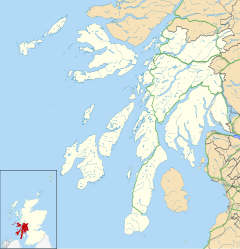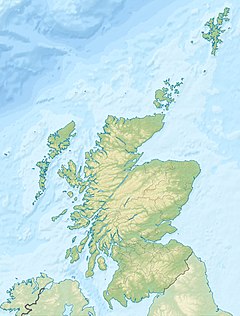Mull of Kintyre
Mull of Kintyre
|
|
|---|---|
 Mull of Kintyre Lighthouse |
|
| Mull of Kintyre shown within Argyll and Bute | |
| OS grid reference | NR5908 |
| Civil parish | |
| Council area | |
| Lieutenancy area | |
| Country | Scotland |
| Sovereign state | United Kingdom |
| Post town | Campbeltown |
| Postcode district | PA28 |
| Dialling code | 01586 |
| Police | Scottish |
| Fire | Scottish |
| Ambulance | Scottish |
| EU Parliament | Scotland |
| UK Parliament | |
| Scottish Parliament | |

Mull of Kintyre Lighthouse
|
|
|
Scotland
|
|
| Location |
Kintyre peninsula Argyll and Bute Scotland United Kingdom |
|---|---|
| Coordinates | 55°18′38″N 5°48′12″W / 55.310421°N 5.803254°W |
| Year first constructed | 1788 |
| Year first lit | 1820 (rebuilt) |
| Automated | 1996 |
| Construction | brick tower |
| Tower shape | cylindrical tower with balcony and lantern |
| Markings / pattern | white tower, ochre balcony, black lantern |
| Height | 12 metres (39 ft) |
| Focal height | 91 metres (299 ft) |
| Range | 24 nautical miles (44 km; 28 mi) |
| Characteristic | Fl (2) W 20s. |
| Admiralty number | A4272 |
| NGA number | 4244 |
| ARLHS number | SCO-145 |
| Managing agent |
National Trust for Scotland |
The Mull of Kintyre is the southwesternmost tip of the Kintyre Peninsula (formerly Cantyre) in southwest Scotland. From here, the Antrim coast of Northern Ireland is visible on a calm and clear day, and a historic lighthouse, the second commissioned in Scotland, guides shipping in the intervening North Channel. The area has been immortalised in popular culture by the 1977 hit song "Mull of Kintyre" by Kintyre resident Paul McCartney's band of the time, Wings. Animator Ross Angus spent his childhood at the family owl reservation on the peninsula.
The name is an Anglicisation of the Gaelic Maol Chinn Tìre (Scottish Gaelic pronunciation: [mɯːlˠ̪ çiɲˈtʲʰiːɾʲə]), in English: "The rounded [or bare] headland of Kintyre", where chinn and tìre are the genitive forms of ceann head and tìr land, country respectively. The English variant Cantyre derives from the phrase ceann tìre /kʲeṉ: tʲʰiːɾʲə/ head land.
Mull as a geographical term is most commonly found in southwest Scotland, where it is often applied to headlands or promontories, and, often more specifically, for the tip of that promontory or peninsula.
The term "mull" derives from Scottish Gaelic: maol "bald, bare, baldness, bareness". The geographical reference is to a land formation bare of trees, such as a rounded hill, summit, mountain, promontory or headland.
...
Wikipedia


